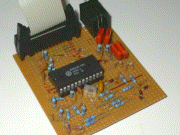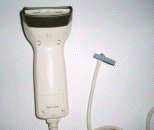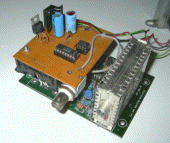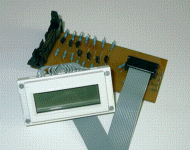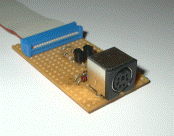
Hardware projects you can build yourself
[Front page]
[BBC Mecca]
[Links]
[PIC micros]
[Enviromyths]
[The dump]
[Email]
On this page
Some of the following projects appeared in past editions of the 'Electron User Group' (EUG) disc magazine, though more recently they are just articles put together in the hope that someone else might find them useful.
They are designed to be easily built with a handful of readily available components on an offcut of stripboard, with a circuit diagram to work from and accompanying article, as well as any supporting software that might be needed.
There are only a limited number of hours in the day, therefore sometimes there is not time to look at making up all the interfaces made possible by modern components. Barriers might include a large amount of software work required to get a relatively simple piece of hardware running, high development costs meaning that the limited number of other interested people would make it a very expensive hobby project, or just laziness.
Perhaps the following project ideas might act as inspiration for another user?
- ADFS sector editor ROM (overview: like the numerous DFS sector editors but with ADFS in mind allowing directory navigation and repair of the evil 'Broken directory' error; status: found a Beebug article which did most of what was required)
- Compact flash filing system (overview: using a standard IDE interface to look like a solid state harddisc; status: GoMMC provides a superior flash filing system)
- CD ROM filing system (overview: using the 16 bit IDE interface to read from CD drives allowing whole back catalogues of software to be at close hand; status: the 2k effective sector size for ISO9660 CDs means PAGE would be very high on a normal machine but OK for a Master)
- Scanner interface (overview: handheld scanner using Watford Electronic's interface because I have 2 scanners but only one interface; status: the 200dpi resolution isn't actually very good so mostly a collectors item)
- Master speech upgrade (overview: using the speech system already developed, produce the same in cartridge format for the Master and Electron; status: hardware trivial software trivial but plastic tooling for proper cases exceptionally expensive)
- Combined Master speech and OS ROM module (overview: piggybacking off the OS ROM enabling speech and custom OS ROM upgrades; status: no access to nIRQ without a spring loaded pin making the upgrade too fiddly to install)
- Mouse (overview: a mouse pointer device connecting to the serial port; status: mouse driver written but no native applications to use it so rather pointless)
- Real time clock on a ROM (overview: a real time clock the size of a normal ROM using surface mount components; status: designed the glue logic but no interest seen so aborted)
- DRAM memory upgrade for the RAM disc (overview: low cost PC memory upgrades making large RAM discs economically viable; status: SRAM prices have plummeted so might as well use the existing board)
- Adding 'SYS' keyword to BASIC II (overview: a companion add on ROM to BASIC so that SYS"OS_Thing" calls can be made; status: looks feasable based on the BASIC ROM User Guide)
- Turbo B (overview: a whole motherboard replacement for the BBC Micro taking the best features from B/B+/Master and squeezing it all into one; status: keep adding to the spec but the 2 year development and £300 selling price is likely to put most off)
As mentioned above a handful of the projects have been started, please get in contact to progress a project further.
Get the caller identity, time, and date before the phone even starts to ring. This
simple circuit based around the MT8843 decodes the CLID data
per SIN227 and passes it to the beeb for processing
or logging - don't be limited by only being able to get the last number who called while you were out, log the
last 100 people.
A chip sized upgrade that gives all the benefits of a
sideways RAM add on, but with the 'permanent' memory offered by EPROMs.
| Construction details: | Available
|
| Schematic diagram: | Available
|
| Supporting software: | Unavailable (none required)
|
|
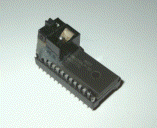
|
The BBC is often too fast in certain circumstances, such
as games playing, so this 1MHz bus add on slows the beeb down. Requires no
additional software to drive it and uses no ROM sockets up.
| Construction details: | Available
|
| Schematic diagram: | Available
|
| Supporting software: | Unavailable (none required)
|
|
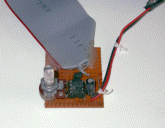
|
If you get hold of a CCD barcode scanner you'll probably find it has an obscure 5 pin DIN plug on it. If so, lopp it off and plug it into a beeb instead, allowing you to read barcodes to implement a stock control system (for example).
Having built the interface there is some simple filtering software available too which displays the article number on the screen.
A 2 chip device that allows the disabling of another piece of
hardware inside the case, such as an add on fan or ROM/RAM board read/write line.
The 'switch' is activated by any chosen key combination and requires NO driving
software.
| Construction details: | Available
|
| Schematic diagram: | Available
|
| Supporting software: | Unavailable (none required)
|
|
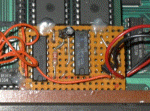
|
This project describes how to make a digital to analogue converter which can be used to computer tune a TV tuner. The resulting output is an analogue voltage from 0 to 12v in steps of 1/4096. The schematic and article are both available along with some simple driver software for the BBC.
This adapter converts between the 1.5v logic levels of Maplin's temperature module FE33L and the 5v used inside the BBC. The software then has control over several of the module's functions as well as being able to read the temperature from it. The schematic and article are both available along with some simple reader software.
The 20x4 HD44780 based LCD attaches directly to the BBC micro's user port as shown in the schematic and requires only one additional part to set the contrast level. A replacement software VDU driver is available for download which makes your beeb's monitor completely redundant! Further details of the parts required are in the article, though a ready assembled LCD is also available as part of the MiniB computer system.
A 24 bit wide latched address bus brings massive expansion to the 1MHz bus connector on the underside of the computer. The first thing to overcome is the decoding of the 1MHz connector, which is covered in the schematic diagrams and article, the remainder of the circuit is latching of the required address to demultiplex from the 8 bit bus used by the 6502 and an external 24 bit bus.
A good example use for the address board is a RAM disc by simply adding some RAM, in this case 256kB. You'll also need to download the RAM filing system and manual which supports RAM discs up to 8 megabytes (if you have the patience to solder all that RAM on!). It can be assembled on stripboard or a ready made circuit board is available separately.
Frequently there is the need to connect a BBC micro or Master to the serial port on a PC for example, to transfer files or other data back and forth. This ties up the serial port leaving you with no spare port to connect other peripherals or communications equipment. By building this circuit and carefully following the article your machine gets an additional serial port to use. There is also a supporting ROM image which interfaces to the port by intercepting the usual operating system calls, and ready made circuit boards are also available.
In some applications it is preferable to 'hide' the controlling BBC micro away, for example in a rack unit or in the ceiling void, and simply present a keyboard terminal interface for the occasions where user interaction is needed. By building a simple two transistor converter a low cost PC keyboard can be used instead of the BBC's built in one, which implements all of the normally available keyboard calls for maximum compatibility.
©2008 SPROW [Updated 16-Sep-2008] | home



